
|
|
10 November, 1998
Wow, the dorm here at McMurdo was loud last night! I was wearing
earplugs and still could hear people around 3:00 am...not at all like
Lake Bonney. I woke up at 6:30 am with the intention of catching up on
my journaling today.
I ate breakfast and made a flight request for tomorrow's lunches (Ed,
Nina, John, Chris, and I will be coring at Lake Trough tomorrow). I was
at the computer lab by 7:15 am and did not move from the computer until
12 noon! Yes, I wanted you to know I am dedicated to sharing my
adventure with you...: )
I returned to the lab to see if there was anything I could be doing for
our trip tomorrow. I acid-washed some 125-ml sample bottles for Chris
(this ensures that they are very clean) and finished a sediment weighing
for him.
As it seemed there was a break in the action, I decided to visit the old
aquarium on the ice and the new aquarium at Crary to see what they were
collecting and studying from the sea. They had huge tanks of Antarctic
Cod (they are huge!...the largest one they have caught in the past was
1.65 m and 240 lbs.). [Did you notice how I mixed the metric and
English system there?] There were tanks of sea urchins, starfish,
sponges, worms, sea squirts, sea anemones, dragon fish, and fish called
Trematomus Bernachii. These fish would swim along the top of the tank
and stick their faces out of the water all along the length of the tank,
looking like they were trying to get air. The scientists are not quite
sure why they do that. I met Ed Wren, working on Petzel's project, who
was very willing to explain to me what he was doing in the lab. I
caught him in the middle of working on a fish. He was injecting
cortisol implants into tranquilized Trematomus Bernachii so that they
could study the effects of the hormone on the levels of salt in their
blood. These fish normally have double the concentration of salt in
their blood (maybe helping them not freeze as quickly?). They are also
using thyroid and prolactin implants to compare the differences between
the hormones and the roles of the hormones on salt regulation. Pretty
interesting stuff...
I saw my first bird since I've been here-- a skua. Skuas are large,
gull-like birds that love garbage or penguin eggs or penguin chicks.
They also feed on Antarctic krill at sea. They are some of the first
birds to be seen as it warms up, I guess.
I'll tell you a little about McMurdo in this journal, since I will be
leaving MacTown (as it is called) tomorrow morning for Lake Bonney
again. The U.S. McMurdo Station is Antarctica's largest station. It
can hold up to 1200 people in the summer and only about 200 people
during the winter. Before 1990, the recycling of waste was nil...all
trash used to be hauled out onto the sea ice before the annual breakup
of the ice and dumped. Today, there are extensive measures in place to
recycle at least 70% of all wastes! One exception...the sewage is still
dumped under the ice...they're working on it.
McMurdo has its own hospital, church, post office, weight room, bowling
alley, barbershop, library, video store, two clubs, a coffeehouse,
shuttle buses, fuel tanks, a hydroponics greenhouse, a seawater reverse
osmosis desalination plant, a diving recompression chamber, and myriads
of tiny buildings housing camping equipment, waste management,
electrical supplies, food, etc. McMurdo has an intranet system with all
of the local news and weather on the site. The station's six-page
paper, The Antarctic Sun Times, is published weekly during the summer.
Recreation at McMurdo includes: aerobics, basketball, bicycling,
volleyball, tae kwon do, country dancing, bingo, bowling, chili
cook-offs, art shows, darts, soccer, softball, table tennis, and even
golf. There are Sunday Science Lectures on a variety of subjects,
computer classes, CPR training, the Ross Island Drama Festival, and the
Icestock rock and comedy festival. McMurdo is a small town away from
your home town. Many people are down here for 3 - 4 months and they
want the conveniences of home. It still looks like a small mining town,
though...
At 4:00 pm I went to do a food pull once more. We were running out of
goodies at camp. We had the LTER team come into camp last Thursday, and
we were running a little low on our favorites. I pulled more Raro
packets (a Kool-Aid type drink down here), Tang, granola bars, chocolate
bars, gorp, crackers, soups, and munchies. I also pulled more frozen
goods that we had gone through pretty quickly (pizza dough, halibut
steaks, shrimp, shredded cheese, lunch meats, and frozen veggies).
Since the frozen goods need to be kept frozen, I'll pick up those boxes
tomorrow morning before we are picked up to go to the helicopter.
After eating dinner, I decided to hop on the shuttle to Scott Base (the
Kiwi's base) just 15 minutes over the hill from us. I took some
pictures and did some minor shopping in their store. Scott Base is
actually fairly small and made up of a cluster of lime-green buildings.
It can accommodate up to 70 people in the summer and 11 in the winter.
From their base overlooking the sea ice, I could see huge mounds in the
ice along fracture lines, caused by the pressure of the ice against the
shoreline pushing the ice up into large spectacular formations on the
surface. I returned to McMurdo after about a 45-minute trip.
I caught up on a few errands that I needed to do before we leave
tomorrow...made a list of last-minute things I need to remember to take
to Lake Bonney...and now I'm catching up on this journal and the photos
for today. It's 10:45 pm, and I'm going to bed...I miss you, Dan!
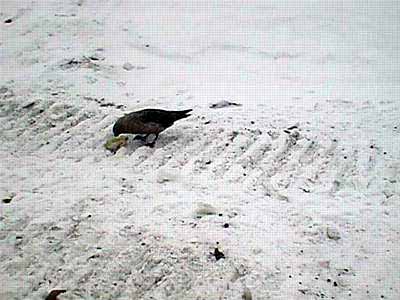
The first bird that I've seen since I've been down here-- a skua.
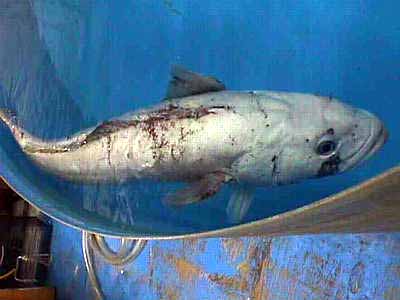
An Antarctic cod. They are about 4 feet long...some are longer. They move very slowly in the tanks of cold water. These are the fish that have the "antifreeze" glycoproteins in them that the scientists are studying.
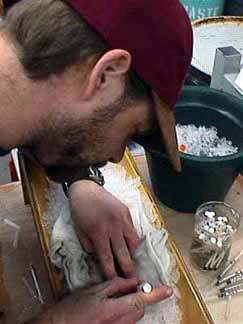
Ed Wren injecting the Trematomus Bernachii with a cortisol implant.
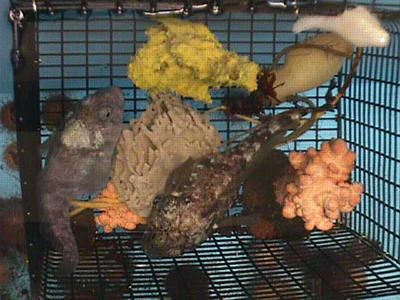
This is a basket that was hanging in one of the tanks. I don't know if you can make them out, but there are two pregnant female Trematomus Bernachii in the basket. Up in the right hand corner is a sea squirt. You can see lots of sponges and one soft coral in the picture. All of this came from the Antarctic sea!
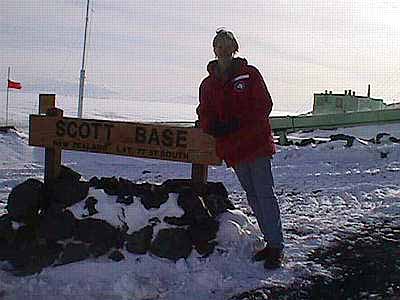
Me at Scott Base. The sun was directly behind me, so I don't know if you can read the Scott Base sign.
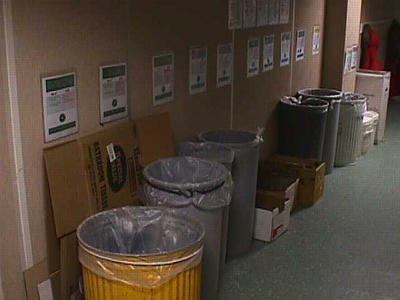
The myriads of recycling cans for aluminum, clothing, construction debris, plastic, food waste, hazardous waste, heavy metals, light metals, magazines, newspapers, wood, white paper, packaging, and glass. There are bins like this everywhere. These bins are in my dorm. They are very serious about recycling. Everyone coming into McMurdo must go through a waste management class.

The Trematomus Bernachii fish in which they are studying hormonal implants. These are the fish that seem to gulp air with half of their bodies out of the water in order to do so. Scientists don't know why they do this.
Contact the TEA in the field at
.
If you cannot connect through your browser, copy the
TEA's e-mail address in the "To:" line of
your favorite e-mail package.
|
